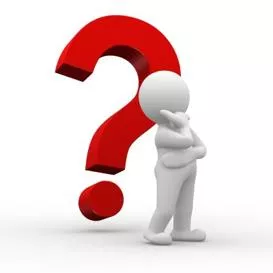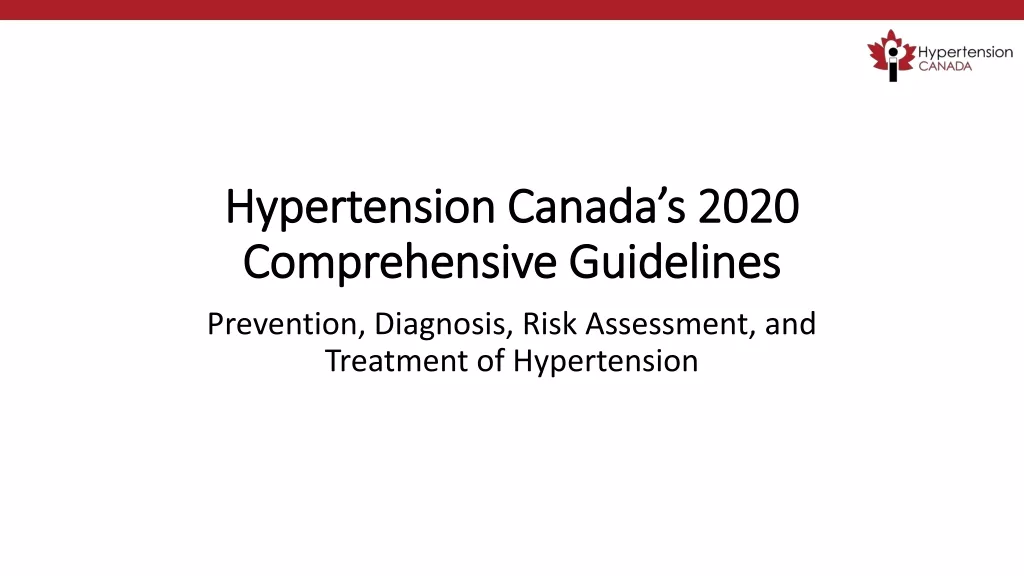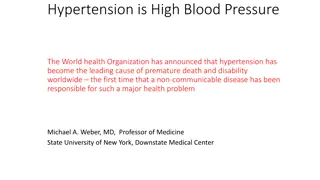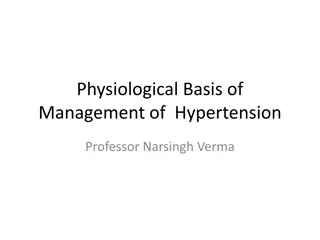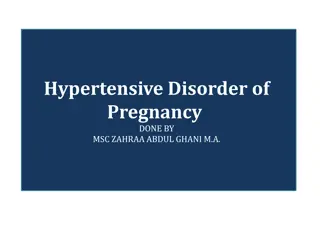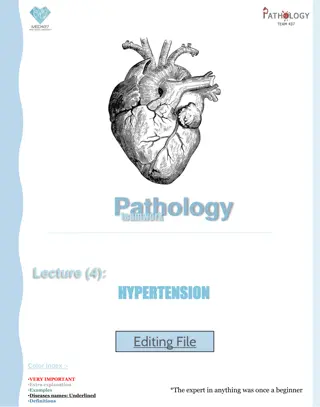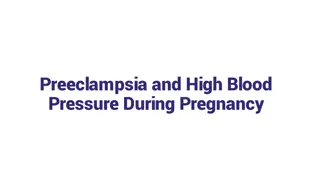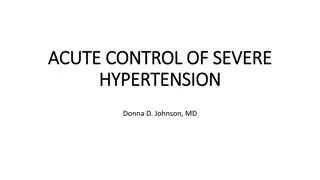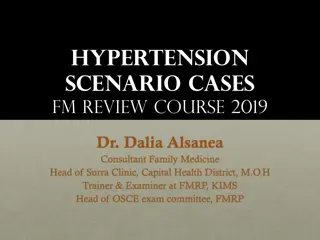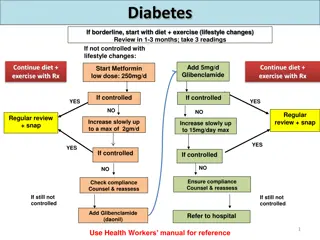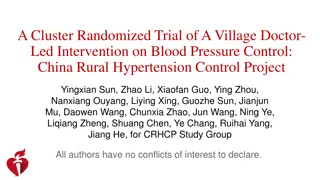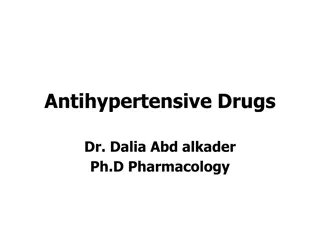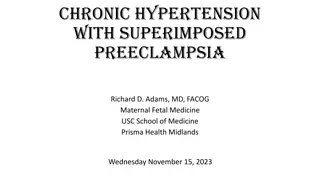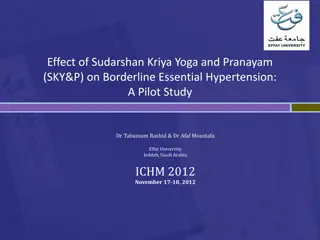Hypertension Management Insights
Cases of hypertension in patients with diabetes and prediabetes. Learn how to measure blood pressure accurately, classify hypertension, and determine initial investigations and treatment goals. Gain valuable insights on managing untreated hypertension in a 60-year-old man.
Download Presentation

Please find below an Image/Link to download the presentation.
The content on the website is provided AS IS for your information and personal use only. It may not be sold, licensed, or shared on other websites without obtaining consent from the author.If you encounter any issues during the download, it is possible that the publisher has removed the file from their server.
You are allowed to download the files provided on this website for personal or commercial use, subject to the condition that they are used lawfully. All files are the property of their respective owners.
The content on the website is provided AS IS for your information and personal use only. It may not be sold, licensed, or shared on other websites without obtaining consent from the author.
E N D
Presentation Transcript
hypertension hypertension TEAM BASED LEARNING PROF : NORAH ALROWAIS
CASE #1 CASE #1 A 59-year-old man with type 2 diabetes presents with concerns about high blood pressure (BP). At a recent visit to his dentist he was told his BP was high. He was reclining in the dentist s chair when his BP was taken, but he doesn t remember the exact reading. He has no symptoms. He has never taken medications for high BP. He takes metformin for type 2 diabetes. His BP is measured once at 146/95 mm Hg in the left arm while sitting. Physical exam is unremarkable except for obesity. ECG is unremarkable.
How would you measure his blood pressure How would you measure his blood pressure
CASE #2 CASE #2 A 62 year old woman with prediabetes presents for her annual physical. She has no complaints. The average of 2 BP readings in her right arm is BP 143/88. Her physical exam is unremarkable except for obesity. She has no history of myocardial infarction, stroke, kidney disease, or heart failure. After the visit, she measures her BP at home and returns 1 month later. The average BP from multiple clinic and home readings is 138/86. Her total cholesterol is 260 mg/dL, HDL 42 mg/dL, and LDL 165 mg/dL. She does not smoke. Is BP readings normal ?
What investigations will you do for hypertensive patient in the initial visit?
CASE #3 CASE #3 A 63 year old man with type 2 diabetes has an average BP of 151/92 over the span of several weeks of measuring at home and in the clinic. He also has albuminuria. What is your treatment goals for his bp?
Case #4: Case #4: You are seeing a 60-year-old man for the first time. He has untreated hypertension (168/106 mm Hg and blood pressure has been elevated on at least 3 occasions). There is currently no evidence of target organ dysfunction (heart, neurological, or eyegrounds). From a therapeutic perspective, what is the best initial approach? A. Initiate treatment with 25 mg of hydrochlorothiazide. B. Consider initiating treatment with a 2-agent combination pill. C. Delay pharmacologic intervention and treat with salt restriction.
Case #5: Case #5: You evaluate a woman with chronic hypertension whose blood pressure remains above target despite a daily regimen of benazepril 20 mg, chlorthalidone 25 mg, and amlodipine 10 mg. Your next step should be: A. Add an agent from another class, such as hydralazine or clonidine. B. Characterize the patient as having resistant hypertension and initiate therapy with 25 mg of spironolactone (potassium levels permitting). C. Add an ARB. D. Switch from amlodipine to verapamil.
Case #6: Case #6: You see a patient whose previous physician has retired. The patient s blood pressure is not controlled on a regimen of hydralazine 20 mg three times a day, atenolol 50 mg daily, and 12.5 mg of hydrochlorothiazide daily. The patient has stage 3 chronic kidney disease (GFR 38 mL/min). You should (choose all that apply): A. Switch the diuretic to chlorthalidone. B. Consider other medications in lieu of hydralazine and atenolol. C. Add clonidine D. Increase hydrochlorothiazide to 25 mg.
Case #7: Case #7: A 58 year old gentleman was found to have elevated blood pressure, with an average clinic blood pressure reading of 180/112mmHg. Being reluctant to wear an ambulatory blood pressure monitor, How would you confirm his high readings ?
What are the clinical indication for home blood pressure monitoring or ambulatory BP monitoring ?
Case #8: Case #8: Having had type 2 diabetes for three years, a 74 year old lady attended her GP practice for her annual diabetes review. During her review, she had her blood pressure taken and was found to have an average clinic blood pressure of 127/78mmHg. However, with a history of stroke in the family and her sister having suffered a recent heart attack, the patient was still very anxious that her blood pressure was too high despite reassurance from the practice nurse. What to do to relieve patient anxiety
Case #9: Case #9: A 65-year-old Caucasian male is referred for management of uncontrolled hypertension.. He does not have known coronary artery disease or stroke. His seated office blood pressure is 168/94 mm Hg (with similar readings in both arms),, his heart rate is 50 beats/ minute. He has a BMI of 32. his blood pressures in other physician office visits have ranged between 165-175/ 92-95 mm Hg over the last year. His current anti-hypertensive medications include: hydrochlorothiazide 25 mg daily, valsartan 320 mg daily, amlodipine 10 mg daily, clonidine 0.2 mg twice daily, and long-acting metoprolol 100 mg daily. He reports compliance with his medication regimen,.
1. What is the goal blood pressure in this patient, based on current recommendations? a. Less than 130/80 mm Hg b. Less than 150/90 mm Hg c. Less than 140/90 mm Hg d. Less than 125/85 mm Hg
Case #10: Case #10: Mr. MK, a 55-year-old man. T2DM and hypertension for 10 years. Medications: Metformin 1 g bd Gliclazide 160 mg bd Amlodipine 10 mg daily Referred for further management of poorly controlled diabetes and hypertension. What are the possible causes for his poorly controlled diabetes and hypertension?
Social history: oSalesman oFrequent travelling oOn and off missed his medications Diet not controlled Family history: oMother diabetic, on dialysis oFather stroke (residual left hemiparesis)
On examination: Obese Weight 98 kg, BMI 35 kg/m2 BP 160/90 mmHg PR 88 beats/minute Bilateral proliferative retinopathy Minimal bilateral leg oedema Other systemic examination: unremarkable
Investigation results: A1c: 9.2 % FBS: 11.8 mmol/L Creatinine: 106 mol/L e-GFR: 88 ml/min/1.73 m2 200 mg/24h urinary protein ECG: LVH
Questions What would be the A1c and BP target? How would you manage him? What would be the choices of anti-hypertensives or anti- diabetic agents?
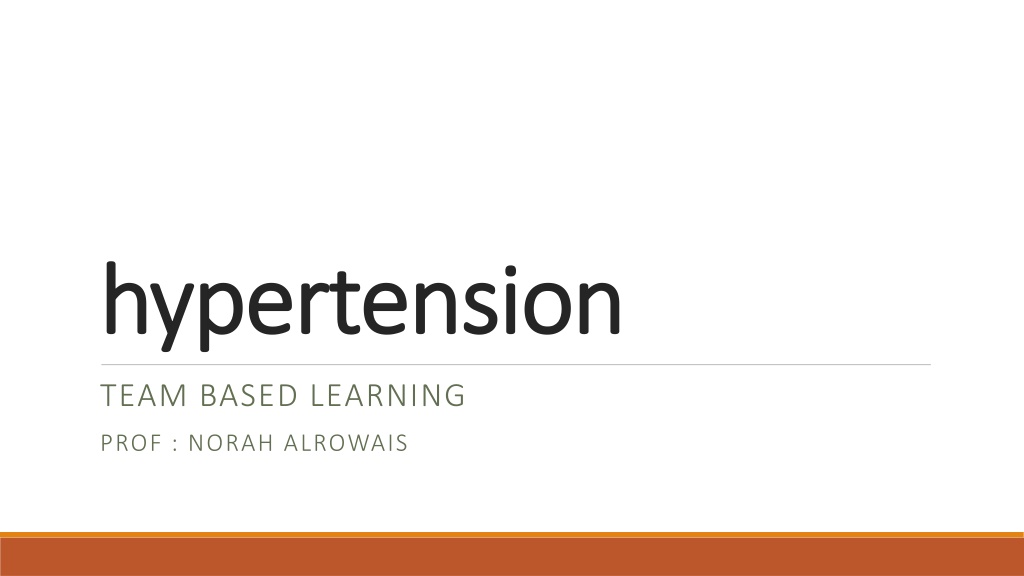
 undefined
undefined






